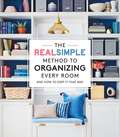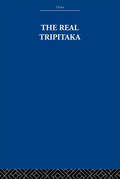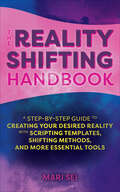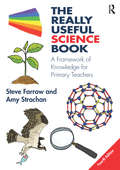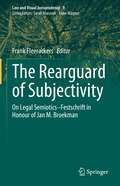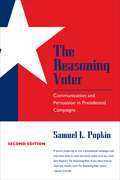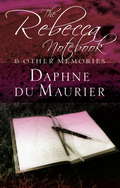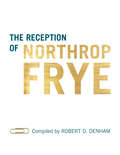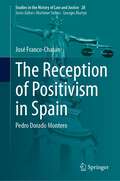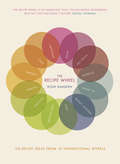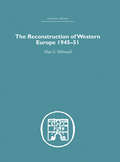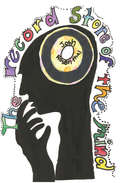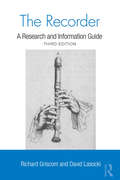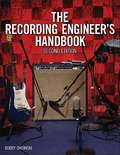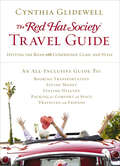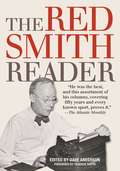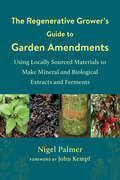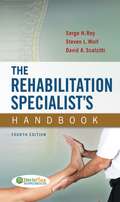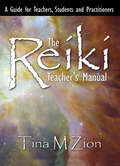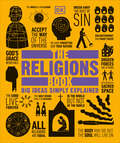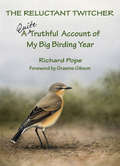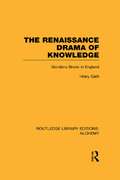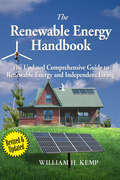- Table View
- List View
The Real Simple Method to Organize Every Room: And How to Keep It That Way
by The Editors of Real SimpleRein in the chaos and regain control of your space. Whether you live in a small space or a large one, Real Simple has the best why-didn't-I-think-of-that advice for creating-and keeping-an easy, stylish, organized home. This practical and inspiring handbook covers everything from how to pare down to cleaning in way less time; from savvy storage solutions to apps that make organizing a snap; from handy checklists and cheat sheets to the most useful products. Organize Every Room is a clutter-busting, timesaving, space-maximizing road map to simplifying your life and creating a happier home.
The Real Tripitaka: And Other Pieces
by Arthur Waley The Arthur EstateFirst published in 1952. The Real Tripitaka gives an account of the seventh century pilgrim's adventures, spiritual and material, both in India and after his return to China. In addition the book contains an account of a Japanese pilgrim's visit to China in the ninth century, which describes the Wu-t'ai Shan, China's great place of Pilgrimage, and an eye-witness's account of the great persecution of Buddhism in 842-845 A.D.
The Reality Shifting Handbook: A Step-by-Step Guide to Creating Your Desired Reality with Scripting Templates, Shifting Methods, and More Essential Tools
by Mari SeiMaster the popular internet sensation with this reference packed with everything you need to know to get started on journeying to your desired reality. You’ve probably heard about reality shifting on TikTok or Facebook, but what is it really and how can you try it? The Reality Shifting Handbook will introduce you to the world of reality shifting and provide you with the resources you need to get started on your shifting journey. This practical guide is packed with helpful information, activities, and routines you can incorporate into daily life to master the power of your subconscious mind and make your shifting journey as fun and easy as possible, including: The origins of reality shifting Various methods for shifting to your desired reality Customizable scripting templates Affirmations for activating your subconscious mind And much more! Perfect for both beginners and those experienced with shifting, The Reality Shifting Handbook is the trusted companion you need to have the best reality shifting journey possible!
The Really Useful Science Book: A Framework of Knowledge for Primary Teachers (The Really Useful)
by Steve Farrow Amy StrachanOffering support to both trainee and practising teachers, the fourth edition of The Really Useful Science Book is the perfect tool for those who wish to extend their subject knowledge, enhance their teaching and create lessons which link directly to the National Curriculum. The easy-to-follow framework provides comprehensive science knowledge for Key Stages 1 and 2 and is fully updated with new material to inspire stimulating and engaging science lessons. The book is divided into three sections: Biology, Chemistry and Physics. Each section integrates key scientific ideas and facts with innovative teaching methods and activity suggestions, and user-friendly language and illustrations help to explain key scientific concepts. With links to global learning, discussion of common misconceptions, and ideas for cross-curricular opportunities, each chapter connects knowledge to practice and informs creative and inspiring teaching. The Really Useful Science Book is an invaluable reference resource for all classroom teachers who wish to develop the confidence to teach enquiry-based practical science with relevance to pupils and their global community.
The Rearguard of Subjectivity: On Legal Semiotics – Festschrift in Honour of Jan M. Broekman (Law and Visual Jurisprudence #9)
by Frank FleerackersEdmund Husserl’s ideas, informed by Kant’s Critiques, constituted a point of departure when rereading philosophical problems of subject and subjectivity. In his “Phänomenologie und Egologie” (1961/63), Jan Broekman revealed how Husserl analysed the “Split Ego” notion in Kant’s vision, which became fundamental for his phenomenology. The form and function of subjectivity were likewise positioned in psychiatry and literature, as well as in aesthetics, as Jan Broekman’s texts on ‘cubism’ demonstrated. Problems of ‘language’ unfolded in studies on topics ranging from the texts of Ezra Pound to the dialogic insights of Martin Buber, all of which were involved in the development of semiotics. Two themes accompanied these insights: the notion and later Parisian mainstream called structuralism, and the urgent need to arrive at deeper insights into the links between Marxism and phenomenology. Central language concepts also played a part: as early as 1986, Jan Broekman published on ‘semiology and medical discourse’, and in 1992 on ‘neurosemiotics’, before addressing the link between speech act and (legal as well as social) freedom in 1993. In all these works, the subject and the atmosphere of subjectivity were essential aspects. In addition to his writing, Jan Broekman gave courses on current philosophical issues, law and medicine until retiring in 1996, and in his “Intertwinements of Law and Medicine” revisited subjectivity aspects, while also offering a synthetic view.In this Festschrift in honour of Jan Broekman, the contributions address the analogue/digital dichotomy in semiotics, the multicultural self in language and semiotics, semiology and legal discourse, the legal subject and the atmosphere of subjectivity, intertwinements of law and medicine, the semiotics of law in legal education, signs in law and legal discourse, making meaning in law, and legal speech acts.
The Reasoning Voter: Communication and Persuasion in Presidential Campaigns
by Samuel L. PopkinThe Reasoning Voter is an insider's look at campaigns, candidates, media, and voters that convincingly argues that voters make informed logical choices. Samuel L. Popkin analyzes three primary campaigns—Carter in 1976; Bush and Reagan in 1980; and Hart, Mondale, and Jackson in 1984—to arrive at a new model of the way voters sort through commercials and sound bites to choose a candidate. Drawing on insights from economics and cognitive psychology, he convincingly demonstrates that, as trivial as campaigns often appear, they provide voters with a surprising amount of information on a candidate's views and skills. For all their shortcomings, campaigns do matter. "Professor Popkin has brought V.O. Key's contention that voters are rational into the media age. This book is a useful rebuttal to the cynical view that politics is a wholly contrived business, in which unscrupulous operatives manipulate the emotions of distrustful but gullible citizens. The reality, he shows, is both more complex and more hopeful than that."—David S. Broder, The Washington Post
The Rebecca Notebook: and other memories (Virago Modern Classics #129)
by Daphne Du MaurierBy the bestselling author of RebeccaINTRODUCED BY ALISON LIGHTIn her own words, Daphne du Maurier reveals what led her to write Rebecca, one of the most beloved books of the twentieth century. This perfect companion volume, The Rebecca Notebook, outlines how Rebecca came to be written, tracing its origins, developments and the directions it might have taken. The author reveals how she first came upon the secret house hidden deep in Cornish woodland, that was to become the setting for her most famous novel: a house which stood derelict, and which she lovingly restored to create her own home - the inspiration for Manderley.Further memories introduce other members of her family: her father Gerald, the famous actor; her grandfather George, the Punch artist; and her cousins, for whom J. M. Barrie wrote Peter Pan.
The Rebecca Notebook: and other memories (Vmc Ser. #665)
by Daphne Du MaurierBy the bestselling author of RebeccaINTRODUCED BY ALISON LIGHTIn her own words, Daphne du Maurier reveals what led her to write Rebecca, one of the most beloved books of the twentieth century. This perfect companion volume, The Rebecca Notebook, outlines how Rebecca came to be written, tracing its origins, developments and the directions it might have taken. The author reveals how she first came upon the secret house hidden deep in Cornish woodland, that was to become the setting for her most famous novel: a house which stood derelict, and which she lovingly restored to create her own home - the inspiration for Manderley.Further memories introduce other members of her family: her father Gerald, the famous actor; her grandfather George, the Punch artist; and her cousins, for whom J. M. Barrie wrote Peter Pan.
The Reception of Northrop Frye
by Robert DenhamThe widespread opinion is that Northrop Frye’s influence reached its zenith in the 1960s and 1970s, after which point he became obsolete, his work buried in obscurity. This almost universal opinion is summed up in Terry Eagleton’s 1983 rhetorical question, "Who now reads Frye?" In The Reception of Northrop Frye, Robert D. Denham catalogues what has been written about Frye – books, articles, translations, dissertations and theses, and reviews – in order to demonstrate that the attention Frye’s work has received from the beginning has progressed at a geomantic rate. Denham also explores what we can discover once we have a fairly complete record of Frye’s reception in front of us – such as Hayden White’s theory of emplotments applied to historical writing and Byron Almén’s theory of musical narrative. The sheer quantity of what has been written about Frye reveals that the only valid response to Eagleton’s rhetorical question is "a very large and growing number," the growth being not incremental but exponential.
The Reception of Positivism in Spain: Pedro Dorado Montero (Studies in the History of Law and Justice #28)
by José Franco-ChasánPedro Dorado Montero was one of Spain’s most relevant authors. He contributed to modern Criminal law and Penology with a very unique theory: the Protective Law for Criminals. In a time when neoclassical penal theories and new positivist theories clashed, Dorado Montero’s proposal served as a bridge between the criminal law conceptions of the 19th and 20th centuries.In order to explore his role in the introduction of positivism within Spain and the subsequent success of this trend, this book addresses several aspects. The first three analyzed are his scholarly career, the historical and international context in which he lived, and the various European and other international influences he was exposed to. On this basis, two major points are then discussed.Firstly, Dorado Montero has been traditionally included within the movement known as correccionalismo. However, his legal-philosophical and criminal thought indicates otherwise. It seems to lie closer to positivism than to neoclassical positions. This research aims at challenging the accuracy of the ‘eclectic’ label which traditional historiography has applied to him.In turn, Dorado Montero described a reality in which every moral value and legal representation was a mere product of mankind’s imagination. Man is responsible for the elaboration of morals, law and culture in his own mind. Thus, for him, there were as many moral and legal orders as there were human beings on the planet. Such a claim is polemic even today. Unsurprisingly, the author received criticism from both neoclassical and positivist schools. Thus, the existence of a ‘Doradian positivism’ is explored. Despite the growing interest in these topics over the last few decades, Dorado Montero has somehow been overlooked – even though his Derecho protector de los criminales described the criminal law of the future as well, one that will have to face the new neurological, medical, psychological and genetic challenges of our time.
The Recipe Wheel
by Rosie RamsdenRosie Ramsden has invented a whole new way of planning meals: it's called The Recipe Wheel. She takes one simple, core recipe – like risotto – that sits at the centre of its own recipe wheel. From there lead spokes or threads to new, more developed recipes – select your perfect dish by occasion, budget or time. Each wheel is like a mind map, bringing flavours together and encouraging the reader to mix and match, adding to their own creativity and cooking skills. A basic roast chicken inspires dishes like chicken, mango and cashew nut curry; white bread goes into beetroot panzanella or butterbean, garlic and thyme on toast. Get creative with risotto with Barley risotto with chestnut and savoy. A simple sponge cake becomes three-tier vanilla raspberry cake, and custard is transformed into rhubarb treacle creme brulee or peach and amaretto trifle.It's a completely original idea – the book will be illustrated only with the recipe wheel graphics. This innovative cookbook, from an exciting new voice in cookery, turns the idea of the traditional recipe book on its head.
The Reconstruction of Western Europe 1945-1951
by Alan S. MilwardFirst Published in 2005. Routledge is an imprint of Taylor & Francis, an informa company.
The Record Store of the Mind
by Josh RosenthalIn your hands "the Keys To The Kingdom" ... a ceaseless whirligig of histories, opinion and romance ... of characters and circumstance minor and major contributors to our great wonderland ... music beloved music ... I reveled within and learned much ... a unique work -- Robert Plant"Josh Rosenthal is a record man's record man. He is also a musician's record man. He is in the line of Samuel Charters and Harry Smith. In this age where we have access to everything and know the value of nothing, musicians need people like Josh to hear them when no one else can." T Bone BurnettGrammy-nominated producer and Tompkins Square label founder Josh Rosenthal presents his first book, The Record Store of the Mind. Part memoir, part "music criticism", the author ruminates over unsung musical heroes, reflects on thirty years of toil and fandom in the music business, and shamelessly lists some of the LPs in his record collection. Crackling with insightful untold stories, The Record Store of the Mind will surely delight and inspire passionate music lovers ... especially those who have spent way too many hours in record stores.Celebrating ten years in 2015, Rosenthal's San Francisco-based independent record label Tompkins Square has received seven Grammy nominations and wide acclaim for its diverse catalog of new and archival recordings.
The Recorder: A Research and Information Guide (Routledge Music Bibliographies #Vol. 2)
by Richard W. Griscom David LasockiA Choice "Best Academic" book in its first edition, The Recorder remains an essential resource for anyone who wants to know about this instrument. This new edition is thoroughly redone, takes account of the publishing activity of the years since its first publication, and still follows the original organization.
The Recording Engineer's Handbook (2nd edition)
by Bobby OwsinskiWorking as a recording engineer presents challenges from every direction of your project. From using microphones to deciding on EQ settings, choosing outboard gear to understanding how, when and why to process your signal, the seemingly never-ending choices can be very confusing. Professional Audio's bestselling author Bobby Owsinski (The Mixing Engineer's Handbook, The Mastering Engineer's Handbook) takes you into the tracking process for all manner of instruments and vocals-- providing you with the knowledge and skill to make sense of the many choices you have in any given project. From acoustic to electronic instruments, mic placement to EQ settings, everything you need to know to capture professionally recorded audio tracks is in this guide.
The Red Hat Society Travel Guide: Hitting the Road with Confidence, Class, and Style
by Cynthia GlidewellThe perfect US travel guide for women, baby boomers and beyond, who want to become savvy, safe travelers, and have fun doing it.Whether you already belong to a Red Hat Society chapter or just want more fun and pizzazz in your life now that you have time to indulge, this book answers every nagging question and includes practical tips and helpful info on:Deciding when and where to goTaking a trip with your girlfriendsChoosing where to eat and stay in twenty top vacation destinationsTraveling by train, plane, and autoAnd more!Full of advice and tips from the ladies of The Red Hat Society, this fun, informative guide addresses your greatest travel concerns, such as negotiating airport security and staying healthy and safe, and simplifies the sometimes complicated tasks associated with traveling, like reading subway maps or understanding the rules of tipping. Discover hundreds of fabulous boutique hotels, favorite local restaurants, and insider tips on shopping, all recommended by Red Hat Society members around the country!For time- and money-saving ideas, safety tips, packing and shopping plans, and destination suggestions that span the USA from the Golden Gate Bridge to the Brooklyn Bridge, turn to The Red Hat Society Travel Guide.
The Red Smith Reader
by Dave Anderson Terence SmithAwarded the Pulitzer Prize in 1976, Walter Wellesley "Red" Smith is considered one of the greatest sportswriters ever to live. Put alongside Ring Lardner, Red Smith was beloved by those who read him because of his crisp writing and critical views.Originally released in 1982, The Red Smith Reader is a wonderful collection of 131 columns with subjects ranging from baseball and fishing to golf, basketball, tennis, and boxing. As John Leonard of the New York Times appropriately stated, "Red Smith was to sports what Homer was to war."With a fantastic foreword by his son, successful journalist Terence Smith, The Red Smith Reader shows true sportswriting from one of the masters of the craft. The writing and style of Red Smith will live forever, and this collection's look into the past at what he saw and covered shows how far sports and sportswriting have come in our country.
The Regenerative Grower's Guide to Garden Amendments: Using Locally Sourced Materials to Make Mineral and Biological Extracts and Ferments
by Nigel PalmerRevitalize your garden—and go beyond compost—by making your own biologically diverse inoculants and mineral-rich amendments using leaf mold, weeds, eggshells, bones, and other materials available for little or no cost!In The Regenerative Grower&’s Guide to Garden Amendments, experimental gardener and author Nigel Palmer provides practical, detailed instructions that are accessible to every grower who wants to achieve a truly sustainable garden ecosystem—all while enjoying better results at a fraction of the cost of commercial fertilizer products. These recipes go beyond fertilizer replacement, resulting in greater soil biological activity and mineral availability. They also increase pest and disease resistance, yields, and nutrient density.Recipes include:Extracting nutrients from plant residues using simple rainwater techniquesExtracting minerals from bones and shells using vinegarFermenting plant juices and fishCulturing indigenous microorganisms (IMO)Inspired by the work of many innovative traditional agricultural pioneers, especially Cho Ju-Young (founder of the Korean Natural Farming method), The Regenerative Grower&’s Guide to Garden Amendments also includes a primer on plant-soil interaction, instructions for conducting a soil test, and guidance on compost, cover cropping, mulching, measuring the quality of fruits and vegetables using a refractometer, and other aspects of sustainable gardening—making it a must-have resource for any serious grower.
The Rehabilitation Specialist's Handbook (Fourth Edition)
by Serge H. Roy Steven L. Wolf David A. ScalzittiThe 4th Edition of the gold standard of rehabilitation resources is now in full color and thoroughly revised and updated to reflect the art and science of practice today! A compendium of frequently used, but rarely memorized information organized for easy reference, it covers an extraordinary breadth of topics--from the full range of basic scientific information (neuroanatomy and clinical neurology, osteology and clinical orthopedics, general anatomy, cardiac and pulmonary anatomy) to the treatments and methods used in modern rehabilitation practice. With its outcome and evidence-based focus and several expert contributors, this text is a must for PT's at any stage in their career.
The Reiki Teacher's Manual: A Guide for Teachers, Students, and Practitioners (The Reiki Healing Series #1)
by Tina M. ZionThis book is designed for students, practitioners, and teachers. It will enrich the classes that current teachers are giving and gives the new teacher confidence and pride when providing that very first class. Practitioners will have a greater understanding of how to apply Reiki and what is actually happening during a session. You will never again be afraid or even worried about teaching a Reiki class or giving the attunement. You will be pleased and your students will be grateful for the rich content in your classes. "The Reiki Teacher's Manual" is a precise step-by-step guide to instruct all three levels or degrees of Reiki. This manual and its format provide you with: A concise manual that is user friendly; A quick reference to answer student's questions; Consecutive steps with time approximations to make sure you teach all the information and still have plenty of time for the hands on practice sessions. How to get the most for your students during their hands on practice; How to increase the power of your attunement; How to teach the attunement to others; Goals for different segments of each class; Detailed descriptions and uses for the symbols; 15 handouts that are concise, informative, and can be copied from the book; Complete written explanations for each handout; A list of supplies for each level and suggestions for your classroom environment; Guidelines in opening your own Reiki practice; Information regarding state licensing needs; How to avoid issues with physicians and the medical community.
The Religions Book: Big Ideas Simply Explained (DK Big Ideas)
by DKLearn about the primal beliefs to the world&’s great faiths in The Religions Book.Part of the fascinating Big Ideas series, this book tackles tricky topics and themes in a simple and easy to follow format. Learn about Religions in this overview guide to the subject, great for beginners looking to learn and experts wishing to refresh their knowledge alike! The Religions Book brings a fresh and vibrant take on the topic through eye-catching graphics and diagrams to immerse yourself in. This captivating book will broaden your understanding of Religions, with:- Each of the world&’s five major faiths – Islam, Christianity, Judaism, Buddhism, and Hinduism in its own, dedicated section- Packed with facts, charts, timelines and graphs to help explain core concepts- A visual approach to big subjects with striking illustrations and graphics throughout- Easy to follow text makes topics accessible for people at any level of understandingThe Religions Book is the perfect introduction to the world&’s most widely practiced religions, aimed at adults with an interest in the subject and students wanting to gain more of an overview. Here you&’ll find the ideas behind ancient and modern faiths and spiritual philosophies, and the place of religion in the world.Your Religious Questions, Simply ExplainedThis book explores the beliefs that underpin religious traditions around the globe, and how they developed. If you thought it was difficult to learn about the world&’s main faiths, The Religions Book presents key information in a clear layout. Learn the primal beliefs to the world&’s great faiths and the continuing quest for spiritual meaning in our complex world, and get to the heart of what it means to believe in God, and religion&’s place in society, with fantastic mind maps and step-by-step summaries. The Big Ideas SeriesWith millions of copies sold worldwide, The Religions Book is part of the award-winning Big Ideas series from DK. The series uses striking graphics along with engaging writing, making big topics easy to understand.
The Religious Traditions of Asia: Religion, History and Culture
by Joseph M. KitagawaFrom the Encyclopedia of Religion the history of Hinduism, Buddhism, Jainism, and Islam in Asia.
The Reluctant Twitcher: A Quite Truthful Account of My Big Birding Year
by Richard PopeRichard Pope, author of Me n Len: Life in the Haliburton Bush, 1900-1940 and the voyageur epic Superior Illusions, is a recently retired professor of Russian literature and culture at York University and a long-standing member of the Ontario Ornithological Club and the Ontario Field Ornithologists. He and his wife, Felicity, live in Cobourg, Ontario. The human side of birding comes to the fore in The Reluctant Twitcher, a serious yet humorous account of birds and birding and the art of chasing rarities. Richard Pope, a lifelong birder, had successfully avoided this latter pursuit for many years but capitulated in 2007 when he embarked on his "Big Year," the object being to record at least three hundred birds in Ontario within that calendar period. Almost instantly, a relatively normal birdwatcher morphed into a "twitcher," albeit reluctantly, pursuing rare species of birds from Rainy River to the Ottawa and well beyond his wildest expectations. Though it was a challenge that was not without trials and disappointments, Pope describes all his adventures with self-deprecating humour. Not just another book on birding, Pope’s unique approach is supported by an array of exceptional colour photographs.
The Renaissance Drama of Knowledge: Giordano Bruno in England (Routledge Library Editions: Alchemy)
by Hilary GattiGiordano Bruno’s visit to Elizabethan England in the 1580s left its imprint on many fields of contemporary culture, ranging from the newly-developing science, the philosophy of knowledge and language, to the extraordinary flowering of Elizabethan poetry and drama. This book explores Bruno's influence on English figures as different as the ninth Earl of Northumberland, Thomas Harriot, Christopher Marlowe and William Shakespeare. Originally published in 1989, it is of interest to students and teachers of history of ideas, cultural history, European drama and renaissance England. Bruno's work had particular power and emphasis in the modern world due to his response to the cultural crisis which had developed - his impulse towards a new ‘faculty of knowing’ had a disruptive effect on existing orthodoxies – religious, scientific, philosophical, and political.
The Renewable Energy Handbook, Revised Edition in Colour
by William H. KempThis revised edition of The Renewable Energy Handbook focuses on the unique requirements of off-grid living as well as using "green" energy for homeowners who remain connected to the electrical utility. The book contains chapters on: Energy efficiency and economics Home heating and cooling and domestic water heating Photovoltaic, wind, and micro-hydro energy generation Battery selection and inverters Backup power, wireless communications, etc. It includes comprehensive specifications for many of the products available in the market today.Whether you are just curious or an industry expert, this handbook will show you how to stretch your energy dollars (doing much more with less) while powering your home with renewable energy. And, unlike fossil fuels or nuclear energy, renewable energy frees you from worry about dumping today's pollution on tomorrow's children.Since its release in 2003, The Renewable Energy Handbook has been a top-selling technology book and is recognized as the best in its field.This edition has been fully revised for 2010 and beyond. It has been increased in size to an easy-to-read 8 x 10 inch format, and it is augmented with hundreds of illustrations, line drawings, photographs, and appendices.Author/engineer William H. Kemp is a leading expert in renewable energy technologies. He and his wife designed and built their own off-grid home, which has all the standard middle-class creature comforts while using no fossil-fuel energy. The author showcases an assortment of homes, including his own, to demonstrate real-world application of the technologies.
